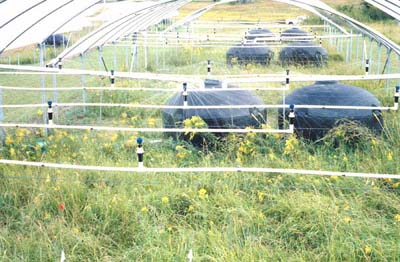 Rainfall Manipulation Plot Study
Rainfall Manipulation Plot Study
Rainfall, Temperature, and Invasive Species Treatments
Experimental manipulations of rainfall and temperature are
conducted in a split-plot design, with rainout shelters (whole plots)
assigned to one of two rainfall treatments, and subplots assigned to one
of two warming treatments.
Rainfall

Ambient precipitation regime
In six of the 12 RaMPs, intercepted water is reapplied to the plots each
time a natural rainfall event occurs. Rain gauges outside the RaMPs and
an in-line flow meter to the sprinkler system allows us to confirm that
precipitation amounts applied inside the RaMPs equal the amounts of rain
falling outside.
Altered temporal rainfall patterns
The other six RaMPs receive this treatment, which
imposes a predicted climate change regime of longer inter-rainfall dry
periods and larger rain events relative to current precipitation patterns.
Assuming a typical growing season rainfall pattern, we lengthen the
intervals between rainfall events by 50 percent, with an event defined as >5 mm
precipitation in a 24 hr period. Thus, a 2-week period between
natural rainfall events (occurring an average of 4 times per growing
season, Fahnestock and Knapp 1994) would be lengthened to 3 weeks. Any
rain falling during these increased dry periods is stored
and applied later as a single, large event at the end of the dry interval.
Thus, individual storm events are larger and intervening dry periods
longer relative to ambient patterns, but the total amount of precipitation
received over the course of the growing season is the same as in the
ambient treatment.
Warming
Each RaMP and unsheltered plot contains 4, 2 x 2m subplots. Two of
the
subplots receive 20-25 W m-2 of downward infrared radiation to the soil surface/plant canopy year
round from infrared lamps suspended 1.2 m above the canopy. A sheet
metal housing identical in size to the lamps is suspended above a third
sub plot to control for the presence of the lamp housing, and the fourth
subplot is unaltered. Lamp height is increased periodically as the
canopy height increases.
Invasive Species
To assess invasibility, we will focus on establishment and persistence
of several target exotic invaders, including a C3 grass (Bromus
inermis), a C4 grass (Sorghum halpense), and a C3 legume (Melilotus officinalis or Coronilla varia).
Seeds will be collected from field populations, and seeds of each species
will be added to 0.1m2 subplots located in four 1.0m2 species composition subplots (two heated, two unheated) within each RaMP,
after spring burning. One heated and unheated 1.0m2 plot
will be dedicated to destructive sampling throughout the growing season,
the others for monitoring of seedling establishment. Seedling
establishment and growth (using destructive (biomass) and nondestructive
(height) measurements), as well as light availability, will be monitored
biweekly throughout growing season. At the beginning and end of the
growing season, cover of resident species will be estimated. Biomass
will be harvested at the end of the growing season. The seed
addition study will be repeated over several years to assess invasion
success across a broader range of soil moisture availability. All
invasive species will be removed at the conclusion of this study to
maintain the integrity of the plant community for future studies.



